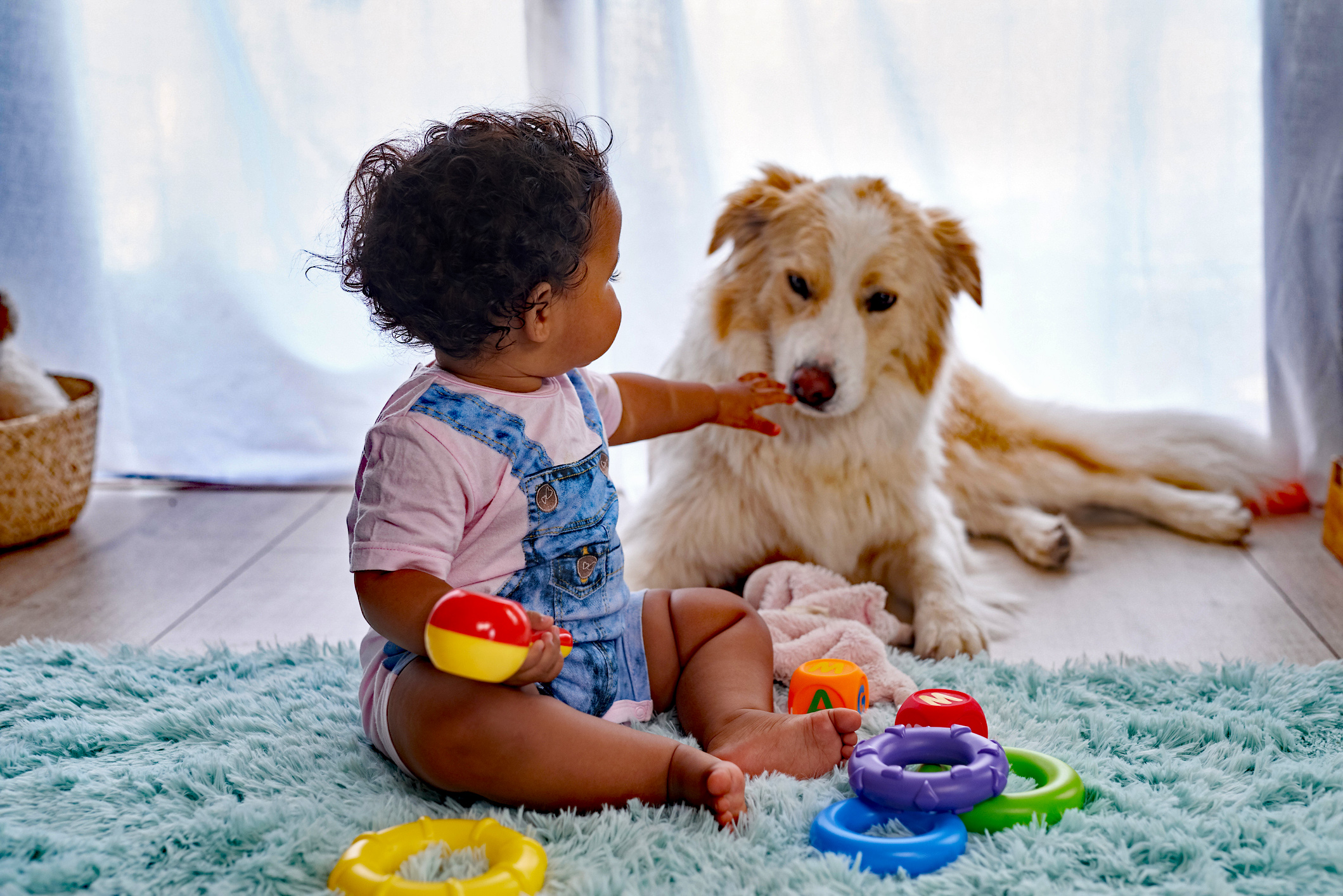And Baby Makes Three

Alexandria, VA – For many people, their dog was their first “baby.” Bringing your new human baby into your home changes the family dynamic. Your dog may have been your baby, but your life with your human baby will change everything.
Preparing your dog for the baby’s arrival is the best way to ensure a safe and successful integration between baby and dog. The early stages of having a new baby at home often may only pique your dog’s curiosity. Usually, it’s only when the baby starts moving – crawling or walking around – that problems arise. So, what’s changed?
A toddler’s sudden mobility can cause your dog new concerns and change their relationship with your baby. Toddlers are notoriously unpredictable creatures, even for the calmest of pets. They crawl—something your dog is not used to seeing humans do. They change speed and direction frequently. They fall a lot. They look like a drunken sailor. They screech and cry. And if they can catch up to a dog, they often reach out to them, stare at them, or try to pull at their fur. It’s a lot for a dog to take. Because growling and snarling are usually a last resort for a dog before biting, it’s vital to notice the subtle behavioral signs of stress and discomfort so that you can separate dog and child before things go wrong.
To help you navigate through these changes and keep both your toddler and dog safe, here are some helpful tips:
Create a Success Station for Your Dog
Whether teaching your dog to stay on a mat, using a baby gate, a tether, or a crate, having a location that provides separation from the baby keeps your baby safe and sets your dog up for success. Baby gates across doorways allow the dog and your toddler to see each other but allow them both the freedom to play and nap without interference from each other. Gates can help keep both your dog and toddler safe. Whether you decide to use a crate, a dog bed, or your dog’s favorite place, set clear limits with your toddler so that he knows that place is off-limits. Remember that leaving a dog alone with a small child is never okay.

Never Leave a Dog and Toddler Unsupervised.
Active supervision is critical to keeping your toddler and dog safe. Toddlers are unpredictable and often uncoordinated. Dogs have the potential to hurt a child, unintentionally or otherwise. To ensure the safety of all your family members, don’t leave a dog alone with an unattended toddler for even a minute. All dogs, even friendly dogs, can bite when pushed to their limits. A toddler only takes a few seconds to pull the dog’s tail or fall onto your sleeping dog. Active and proactive adult supervision should be constant when your dog and baby are together.
Practice Handling Your Dog
Dogs who are used to having all parts of their bodies handled throughout their lives are more likely to accept the uncoordinated handling of toddlers. As soon as possible, begin teaching your dog to love being handled. Practice looking in your dog’s ears, holding his paws, rubbing his fur, and tugging gently on his tail. Talk to him calmly, rewarding him for accepting all types of handling. Your dog should associate handling with good things, like praise and treats.
Teach Your Child to How to Pet Your Dog
Spend time each day teaching your toddler how to interact with your dog. Sit close to your dog with your toddler on your lap. Teach your toddler the “gentle” one-hand stroke long ways on the dog’s back.
Teach Your Toddler to Respect Your Dog’s Things
While many dogs tolerate having a child play with their toys, bones, or food bowls, some do not. Teaching your toddler to leave your dog’s things alone would be best. Give your dog space and privacy while they eat. Teach your toddler how to give treats to your dog. If your child picks up the dog’s toys or the dog picks up the child’s toy, exchange it for one of their own. Since some toddlers may be too young to understand the rules, using exercise pens to delineate baby and dog toy areas will reduce confusion between both parties. These days, dog and baby toys look very similar.

When to Get Help
You should start preparing your dog at least six months before the baby’s arrival. If you are uncomfortable with your dog’s body language around your baby or toddler, or if your dog has growled, snapped, nipped, or bitten your toddler, you should consider contacting a positive trainer experienced in this area. Wholistic Hound Academy has professional licensed Family Paws Parent Educators who can help. Check out our upcoming Expectant Parent workshops. Positive reinforcement works well for dogs and toddlers. It is the best way to teach dogs and toddlers how to live together in a safe and happy environment.
Sandy Modell, CPDT-KA, is the Founder, Owner, and Head of Training of Wholistic Hound Academy, Alexandria’s award-winning, premier canine training and learning center — offering classes and private lessons in puppy training, adolescent and adult foundation and life skills, behavior modification, agility & dog sports, fitness, babies/kids and dogs, pre-pet planning and selection. Classes are starting soon! Check out our Expectant Parents and Kids and Canines classes! Visit www.wholistichound.com to enroll in our programs, like us on Facebook.com/wholistichound, and follow us on Instagram at Instagram.com/wholistichound.
ICYMI: Teaching a Really Reliable Recall




